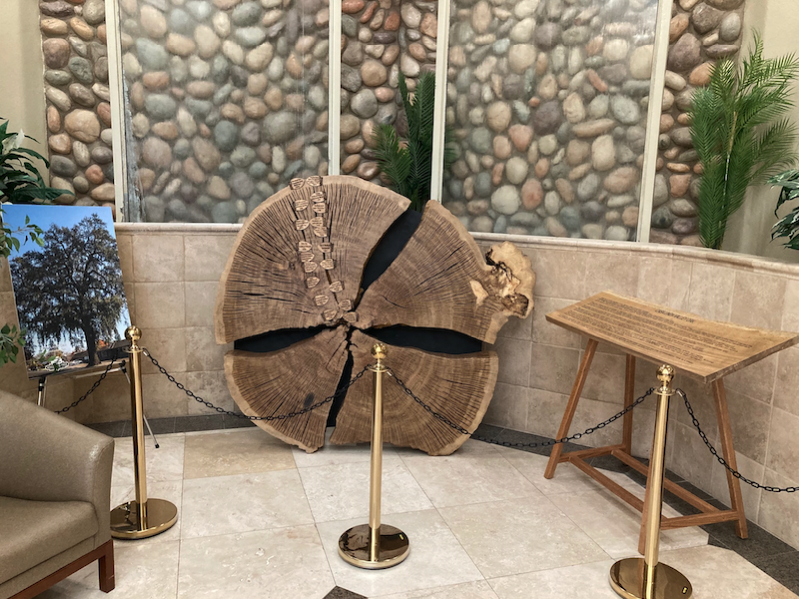In 2021 Woodland lost one of its oldest and largest valley oak trees, which began life as an acorn sprout about 270 years ago when California belonged to Spain. Beginning life in an oak savannah, the tree eventually shaded a farm. By the time the land was subdivided in the 1950s for housing, the oak’s stature was so impressive it was spared the axe and Casa Linda Drive was built around it. However, part of its roots were cut to make room for the street, which likely led to incremental water infiltration and wood decay over the ensuing decades, weakening the tree until it was deemed unsafe.
To honor this extraordinary tree a group of community donors, led by the Woodland Tree Foundation, contributed funds to create a permanent monument from a cross section of the valley oak. This magnificent tree was one of the largest of Woodland’s oaks, dwarfing most trees by its enormous size and weight. The growth rings of this tree show that it began life before the Declaration of Independence was written, a time before large numbers of oaks were cut down for firewood and to clear the way for farming and development.
The tree measured close to 7 feet in diameter, with a height of 87 feet and an estimated weight of 146,000 pounds. Its biomass contained about 34,000 pounds of carbon, which means this single tree absorbed during its lifetime roughly 125,000 pounds of CO2, a greenhouse gas which contributes to global warming. The tree served as a cornerstone for its ecological community, providing shelter and a food source for birds, insects, wildlife, domestic animals, as well as people.
To create this monument, the massive cross section of the tree trunk was dried in a kiln at Street Tree Revival (STR), an urban wood recycling program of West Coast Arborists. The loss of moisture content shrank the tree cutting from its original size and caused the wood to break into four “pie slices” which STR craftsmen skillfully sanded, polished and mounted on a sturdy steel frame. Important dates in local, state, and national history were marked on the tree’s growth rings by the Tree Foundation. City of Woodland staff member Eric Leggitt built a wooden stand for the context statement, which is etched into a thick piece of the oak; it explains the tree’s history and serves as an educational exhibit for students and community center visitors. A photo of the oak, taken before its demise by Woodland photographer Susan Bovey, is also on display.
The fossil record shows that valley oaks in Woodland and the surrounding Central Valley colonized this area approximately 10,000 to 15,000 years ago. This was about the time that indigenous Patwin people settled here. The Patwin were stewards of the land and sustainably gathered acorns as a key food source for many thousands of years.
The acorn which sprouted the Casa Linda Oak may have been buried by a California scrub jay (Aphelocoma californica), which can cache hundreds of acorns each year as a stored food source.
In 2018 the Woodland Tree Foundation counted 880 valley oaks over 12 inches in diameter throughout the City of Woodland. This is a steep drop-off from the thousands of oaks that once populated this area prior to farming and urban development.

